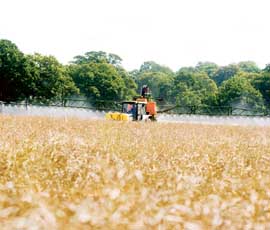VIDEO: Oilseed rape desiccation dilemma

Variable oilseed rape crops mean choosing the right desiccation product and timing applications correctly could be particularly challenging this season, according to our Crop Watch agronomists.
Nick Brown, a ProCam agronomist in Buckinghamshire, said roughly half his crops were even, with no secondary flowering, but the remainder varied from having some secondary flowering, to still flowering for the first time, to plants with nearly mature seed on the main raceme. “In some cases I wonder how we can possibly time the desiccant correctly.”
Patrick Stephenson looks at Cereal leaf beetle damage
If the desiccant was timed with the maturity of the main raceme, as normal, then significant red seed would be in the sample, he explained. “If, on the other hand, we try and wait till more of the late-flowering side branches are mature, then we will risk seed shedding from the, by then, brittle pods at the top of the plant.”
In some crops he reckoned the only option was to apply Pod-Stik as the crop approached the normal desiccation timing, then return with the desiccant later on. “The Pod-Stick should protect the mature pods from shattering and, hopefully, we won’t loose too much seed from the top pods.”
He hoped this approach would minimise levels of red seed in the sample without compromising yield significantly. “But each crop will be different and I think whatever the approach some red seed is an inevitability this year.”
Crops were similarly variable in Yorkshire, said AICC agronomist Patrick Stephenson. “Oilseed rape crops cover the whole range and harvest dates could be variable. “Glyphosate will dominate the desiccation process and will start to be applied in the not-too-distant future. With prices looking very good, some crops will receive a sealant to try and protect yield.”
Spring crops were also variable and spring barley was receiving their final fungicide as the ears emerged, he said. “Spring beans are also receiving a fungicide at mid-flowering to protect against rust and chocolate spot.”
In Suffolk, recent rain had rescued remaining yield potential, but increased the risk of late disease, said Frontier agronomist Brian Ross. “This, in turn, has increased the number of ear sprays being applied and has perhaps increased the yield forecasts for good wheats by 1 to 1.25t/ha, which is a lot better than we were first looking at.”
But the rain had also caused thin crops to put on new growth at the base, which might increase the need for pre-harvest glyphosate applications, he said.
Rain arrived just in time for the sugar beet, particularly for crops on lighter soils, he said. “There are several crops which are showing a lot of magnesium deficiency symptoms, though this may be a symptom of the dry conditions and some of this might disappear with the rain, according to Brooms Barn.”
In Shropshire, winter linseed crops had almost finished flowering and pods were starting to turn pale yellow, said AICC agronomist Bryce Rham. “Crops are generally weed free, but, probably because I have stayed away from Ally (metsulfuron-methyl), I do have some issues with poppies, as one of my clients can verify.”
Chekker (amidosulfuron + iodosulfuron) was applied using a SOLA, but because the weeds were relatively large and it was dry during application, this could have reduced efficacy, he said. “Where pods are turning yellow, seed is still green and leaves are turning yellow pretty much all the way up the crop. I have concerns the glyphosate may not be able to fully get into the plant.
“I’m now thinking that we go with diquat to ensure complete desiccation. This will probably be applied in 10-14 days time, depending on the weather.”
Spud Special
In Yorkshire, some potato crops had patches of damage caused by rhizoctonia, free-living nematodes and PCN, said John Sarup, senior potato consultant at SAC.
A number of his clients had started applied azoxystrobin in the furrow and it seemed to be having an effect on soil-borne rhizoctonia, he said. “Treated crops seem to be producing a much healthier root system, which will increase nutrient and moisture uptake and, consequently, reduce stress.
“In Australia last year, I saw a crop treated with azoxystrobin with six rows left untreated, all other applications were the same. The six untreated rows were defoliated with alternaria – the rest of the field still had over 60% ground cover.”

